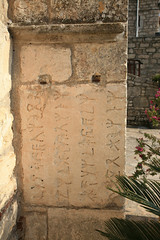David Meadows alerts us that MEFRA (Mélanges de l'Ecole française de Rome. Antiquité) is available online via http://www.persee.fr -- just select it from the drop-down menu. Unfortunately, many or most images are locked out in the free version.
Over at Current Epigraphy, Gabriel Bodard gives us the run-down on a lecture by Michael Crawford on "Language, geography, and economy in early Italy."
For those lucky enough to reside in the greater Philadelphia metro area, there are a couple of events this week pertaining to early Italy:
"Etruscan Treasures of the Vatican Museum"
Dr. Maurizio Sannibale & Dr. Carlo Aurisicchio,
Thursday, 21 February 2008 - 6:30 PM
Penn Museum Classroom 2, University of Pennsylvania
(for more info, see here)
(Updated 2/19: If you're in the DC area, see it here)
"Italic Identity in the Roman Republic and Italian Social War Propaganda"
Gary D. Farney, Rutgers University
Friday, 22 February 2008 - 4:30 PM
Rhys Carpenter Library B21, Bryn Mawr College
Monday, February 18, 2008
Wednesday, February 06, 2008
Spolia update
I'm happy to report that the "Spolia" group on Flickr has grown to 39 members and 206 pictures since its inception on December 27 of last year. I don't anticipate maintaining such a rate of growth, though. I've searched most of the obvious tags (e.g. spolia, re-used, recycled) in as many of the languages as I felt I could do so profitably (English, Italian, French, Spanish, German). Future additions will be more dependent on self-submission by members than on invitations by me. Of course, there are many pictures out there showing spolia without saying so in their description, which makes it harder to find them.
The locations represented are concentrated in Mediterranean Europe, with a good showing from the British Isles, along with, thus far, one from China and one from Chicago. I've decided to keep Spolia broadly defined, including, for instance, the Lothar Cross with its Roman cameo of Augustus embedded in a 10th-century cross.
The Duomo in Pisa is particularly well-represented in the pool with 8 pictures, no doubt due to the frequency with which it is touristed. The Yerebatan Sarayı or Basilica Cistern in Istanbul is very well represented on flickr as a whole, but thus far only one picture has been added to the Spolia pool. Likewise, many pictures of a wall on Paros have been invited, but few have thus far accepted.
For purely epigraphic considerations, the best groups on Flickr that I've seen are "Visible Words - Visibile Parlare" for Latin and the Latin alphabet (1500 photos) and Greek (203 photos). There's also Inscriptiones, but it seems to have died with 19 photos.
The locations represented are concentrated in Mediterranean Europe, with a good showing from the British Isles, along with, thus far, one from China and one from Chicago. I've decided to keep Spolia broadly defined, including, for instance, the Lothar Cross with its Roman cameo of Augustus embedded in a 10th-century cross.
The Duomo in Pisa is particularly well-represented in the pool with 8 pictures, no doubt due to the frequency with which it is touristed. The Yerebatan Sarayı or Basilica Cistern in Istanbul is very well represented on flickr as a whole, but thus far only one picture has been added to the Spolia pool. Likewise, many pictures of a wall on Paros have been invited, but few have thus far accepted.
For purely epigraphic considerations, the best groups on Flickr that I've seen are "Visible Words - Visibile Parlare" for Latin and the Latin alphabet (1500 photos) and Greek (203 photos). There's also Inscriptiones, but it seems to have died with 19 photos.
Subscribe to:
Comments (Atom)

